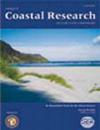Beachface morphology and surf beat sediment transport in laboratory scale surf and swash zones
4区 地球科学
Q3 Earth and Planetary Sciences
引用次数: 14
Abstract
Predicting the evolution of the beachface is important in terms of coastal protection, recreation and environmental sustainability. Swash zone sediment transport plays a major role in this morphological response. However, despite recent advances in swash zone modelling and data collection, specific details are lacking, notably the cross-shore variation in net transport rates, the influence of surf beat and wave groups on swash sediment transport and the effects of the feedback between the surf and swash zones. This paper provides novel data from carefully controlled small-scale laboratory experiments investigating surf beat sediment transport. The data include very detailed observations of the cross-shore distribution of net sediment transport in the surf and swash zones for both eroding and accreting beaches. Further, these distributions are contrasted for monochromatic waves, monochromatic waves with surf beat and bichromatic wave groups with surf beat. In this case, free surf beat is shown to reduce nearshore wave heights and reduce short wave velocity amplitudes. Free surf beat is found to promote onshore sediment transport under accretionary conditions and reduce offshore transport under erosive conditions. Hence, the free surf beat tends to transform the beach toward a reflective state and possibly protects the beach. However, a bichromatic wave group shows the opposite effect. Additional data show the influence of the beach face evolution on the onshore migration of longshore bars, illustrating coupling between swash and surf zone morphology.实验室规模的冲浪区和沼泽区的滩面形态和冲浪拍打沉积物运移
预测滩面的演变对海岸保护、娱乐和环境可持续性都很重要。在这种形态响应中,冲刷带沉积物运移起着重要作用。然而,尽管最近在斜滩区建模和数据收集方面取得了进展,但仍缺乏具体细节,特别是净输 送率的跨岸变化、冲浪节拍和波群对斜滩区沉积物输送的影响以及冲浪区和斜滩区之间的反 馈效应。本文提供了精心控制的小规模实验室实验数据,对冲浪节拍沉积物迁移进行了研究。这些数据包括对侵蚀海滩和增生海滩的冲浪区和斜滩区净沉积物迁移的跨岸分布进行的非常详细的观测。此外,这些分布还与单色波、带有冲浪节拍的单色波和带有冲浪节拍的双色波组进行了对比。在这种情况下,自由冲浪节拍会降低近岸波高,减小短波速度振幅。研究发现,自由冲浪节拍会促进增生条件下的陆上沉积物运移,并减少侵蚀条件下的离岸运移。因此,自由冲浪节拍倾向于将海滩转变为反射状态,并可能保护海滩。然而,双色波群则显示出相反的效果。其他数据显示了海滩面演变对沿岸长条石向岸迁移的影响,说明了冲刷和冲浪区形态之间的耦合关系。
本文章由计算机程序翻译,如有差异,请以英文原文为准。
求助全文
约1分钟内获得全文
求助全文
来源期刊

Journal of Coastal Research
地学-地球科学综合
自引率
0.00%
发文量
87
审稿时长
3-8 weeks
期刊介绍:
The Journal of Coastal Research (JCR) is one of the leading international journals for coastal studies and processes, and is published bi-monthly by the Coastal Education & Research Foundation [CERF]. By covering the entire field of coastal research, the JCR encompasses all subjects relevant to natural and engineered environments (freshwater, brackish, or marine) and the protection/management of their resources in the vicinity of coastlines of the world. Even though the journal broadly focuses on immediate shoreline zones, the JCR also embraces those coastal environments that either reach some indefinite distance inland or that extend seaward beyond the outer margins of the sublittoral (neritic) zone. The JCR disseminates accurate information to both the public and research specialists around the world on all aspects of coastal issues in an effort to maintain or improve the quality of our planet''s shoreline resources.
 求助内容:
求助内容: 应助结果提醒方式:
应助结果提醒方式:


